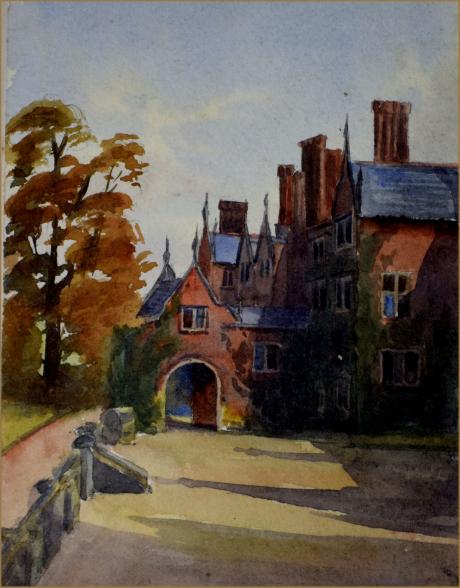inscribed dated and signed by the house guests " 1893 November 25th - 27th Mary Dainell, Robert Smith, Isabel Smith, Marjory Smith, Edward Thesiger, Georgina M Thesiger John A Longley, Leila M Smith Winifred Smith "
Goldings Estate is a large Elizabethan style country house and surrounding land close to Waterford, north of Hertford, Hertfordshire, England. The house was designed by George Devey (1820–1886), constructed between 1871 and 1877, and is a Grade II* listed building.
The earliest known Goldings mansion was built about 1700 for Thomas Hall, Squire of Bengeo. In 1813 the estate was sold to Samuel Smith and inherited in 1861 by his grandson, the merchant banker Robert Smith, son of Abel Smith. Robert was the Sheriff of Hertfordshire for 1869-70. When the new house built by George Devey was completed the older house was demolished.
In 1921 the house was sold to Dr Barnardo's Homes for use as an orphanage and in 1923 was modified and enlarged and a chapel added. In 1960 a new wing was added. In 1967 the orphanage closed and Goldings was purchased by Hertfordshire County Council for use by the County Surveyor's Department.
In 1997 the council sold the property to London-based Harinbrook Properties to be converted into apartments.
“Red brick, English bond, with diaper patterns in blue headers, above a coursed rubble stone base, and with ashlar dressings and stone mullioned windows; Welsh slated roofs with multiple stone-coped parapeted gables, numerous multiple shafted moulded brick chimneystacks with moulded bands and oversailing caps.” (Historic England)
Goldings is a large country house built Elizabethan-style by architect George Devey between 1871 and 1877.
Devey (1820-86) was one of the major Victorian country house architects, designing in a picturesque style, with Elizabethan and Jacobean details, which merged with the evolution of the Arts and Crafts Movement in the late 19th century. A skilled water colourist, Devey’s picturesque massing was based on pictorial composition, but his plans were often rambling and haphazard as at Goldings.
One critic is Mark Girouard who said of Goldings:-
“Devey’s weakness is especially apparent in larger buildings; and his big country houses are very big indeed. However fascinating the plan of a house like Goldings may be as an example of capable planning combined with apparent haphazardness on an enormous scale, the actual house is depressingly shapeless: it seems to dribble on for ever.”¹
The earliest known Goldings mansion was built about 1700 for Thomas Hall, Squire of Bengeo. In 1813 the estate was sold to Samuel Smith and inherited by his grandson, the merchant banker Robert Smith, son of Abel Smith.
Robert Smith (1833-1894) took over the Goldings estate in 1861, and was Sheriff of Hertfordshire in 1869. He was the head partner in the old-established banking firm of Smith, Payne and Smith, of Lombard Street, and a partner in Samuel Smith and Co, Nottingham, Smith Ellison and Co in Lincoln. He married a daughter of Henry John Adeane, of Babraham Hall, Cambridgeshire.
The old Goldings Hall of 1650-60 was demolished around 1875, by which time the new house by George Devey, his biggest country house, was nearing completion.
Following Robert Smith’s death the house passed to his son, Reginald Abel Smith, who died in 1902. His wife, Margaret Alice Smith, remained at Goldings and allowed it to be used as a Red Cross Auxiliary Hospital during World War One.
The estate came to market in 1920 and attracted the interest of the Council of Doctor Barnardo who were looking for premises in countryside surroundings with open fields for recreation.
“One day, sometime around 1920, Mr Ernie Walker was working in the engine room when three well-dressed men came along to see him. They wanted to know whether the house, which at that time was only occupied by an handful of people, was capable of supplying water and handling sewage etc. for up to 260 people. This was the beginning of the negotiations, which led to a very dramatic change for Goldings.”²
In 1921 the house was sold to Dr Barnado’s Homes for use as an orphanage and renamed the William Baker Technical School.
“A great change occurred in April 1922 when the first Barnardo’s boys arrived. Two hundred and sixty from Stepney, led by their own band, marched along the road from the railway station at Hertford and took up residence. Later that year the Prince of Wales (later Edward VIII) came for the official opening of the William Baker Technical School as it was called. The large stables of the mansion were ideal for workshops and in the fifty acres of grounds there was plenty of space for a swimming pool and other sports facilities.”³
In 1923 Goldings was modified and enlarged and a chapel added. A new wing was added north of the arched entry to the forecourt in 1960. In 1967 the orphanage closed and Goldings was purchased by Hertfordshire County Council for use by the County Surveyor’s Department.
In 1997 the council sold the property to London-based Harinbrook Properties to be converted into apartments.


